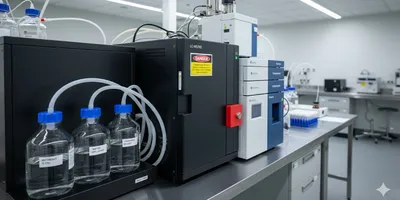The convergence of advanced technology and demanding sample volume has positioned high-throughput screening and testing as the standard for modern analytical labs. These environments rely heavily on volatile solvents for separation and sample preparation, alongside powerful lasers for sensitive spectroscopic analysis. Balancing these risks while maintaining speed and precision remains a key operational challenge for laboratory professionals. Rigorous lab safety standards and optimized processes are essential to protect personnel and preserve experimental integrity in these complex facilities.
Optimizing Solvent Handling and Waste Streams
Effective management of organic solvents is critical in any high-throughput environment, especially given the scale of consumption and resulting waste generation. The volume of hazardous materials used in automated liquid handling and chromatography systems demands strict control over storage, delivery, and disposal to maintain environmental and occupational safety.
Closed-Loop Solvent Systems: Bulk solvents should be pumped directly from centralized reservoirs, minimizing personnel exposure during filling and transfer. This reduces airborne concentrations of volatile organic compounds (VOCs) and improves efficiency by eliminating manual bottle changes.
Key Solvent Management Controls:

A concise visual guide to key Solvent Management Controls—including Vapor Containment, Automated Monitoring, Segregation, and Dispensing Accuracy—essential for high-throughput laboratory environments.
GEMINI (2025)
- Vapor Containment: Use solvent waste ports and safety caps with activated carbon filters to prevent vapor escape.
- Automated Monitoring: Employ sensors to track solvent levels in supply and waste vessels, avoiding overflow or downtime.
- Segregation and Compatibility: Separate waste streams based on compatibility, flammability, and toxicity, especially in labs using diverse chromatographic methods.
- Dispensing Accuracy: Regularly calibrate automated pumps and syringe drivers to minimize waste and optimize solvent use.
Hazardous solvent disposal must comply with local and international regulations. Labs should partner with certified waste disposal vendors and maintain detailed waste records. Solvent recovery and recycling programs—where feasible—can significantly reduce cost and environmental impact, aligning with sustainability goals (EPA Green Chemistry Program).
Essential Laser Safety and Engineering Controls
High-powered lasers used in Raman spectroscopy, particle sizing, or mass spectrometry ionization introduce serious physical hazards. Managing these systems is a fundamental part of high-throughput lab safety.
All laser systems must be classified according to their hazard level (typically Class 3B or Class 4, per ANSI Z136.1–2022). This classification dictates the required engineering and administrative controls.
Mandatory Laser Safety Controls:
| Control Type | Description | Safety Rationale |
|---|---|---|
| Interlocks | Safety switches that shut down or attenuate the beam when enclosures are opened. | Prevents accidental exposure during maintenance. |
| Protective Housing | Opaque enclosures containing the beam and reflections. | Prevents eye/skin contact. |
| Master Key Switch | Keyed control preventing unauthorized use. | Limits access to trained personnel. |
| Beam Stops/Dumps | Non-reflective surfaces that absorb full beam power. | Prevents stray reflections. |
Additional administrative controls include appointing a Laser Safety Officer (ANSI Z136.1, Section 1.3), mandatory personnel training, and posting proper warning signage. Laser alignment and maintenance should follow written SOPs and require appropriate PPE such as OD-rated eyewear.
Integrated Risk Assessment: Combined Solvent and Laser Hazards
A major oversight in many high-throughput facilities is failing to assess combined risks from flammable solvents and intense lasers. Stray or reflected beams can ignite solvent vapors like acetonitrile or methanol, common in chromatography systems.
Mitigation Strategies:
- Spatial Separation and Ventilation: Use explosion-proof exhaust systems (LEV) over solvent dispensing points to maintain VOCs below the Lower Explosive Limit (LEL).
- Solvent Substitution: Replace highly flammable solvents with less flammable alternatives where possible.
- Enclosure Integrity: Ensure laser housings are sealed and solvent-resistant; audit regularly for leaks or damage.
- Fire Suppression Systems: Install localized fire suppression (CO₂, FM-200, or clean agent systems) near combined solvent-laser zones.
Comprehensive risk assessment by a multidisciplinary team (Laser Safety Officer, Chemical Hygiene Officer, and engineers) is essential to address all fault scenarios.
Maximizing High-Throughput Efficiency Through Design
Efficiency in high-throughput labs depends on workflow design that reduces manual handling, waste, and downtime while maintaining safety.
Operational Efficiency Levers:
- Automation of Checks: Use diagnostic routines for laser output and solvent monitoring to minimize manual verification.
- Predictive Maintenance: Replace solvent pump seals and recalibrate lasers on schedule to prevent unplanned failures.
- Digital SOPs: Implement interactive, digital SOPs for tasks like solvent switching or laser alignment.
- Ergonomic Access: Position equipment for safe maintenance, cleaning, and emergency access.
Integrating safety into workflow design enhances both productivity and protection, creating self-monitoring systems where solvent and laser safety are built-in features.
Reinforcing Safety and Efficiency in Analytical Labs
Sustained productivity in modern analytical labs depends on a holistic safety culture. Proper solvent handling, strict laser control, and proactive risk mitigation ensure both operational excellence and personnel protection. Hazard containment and workflow optimization are the cornerstones of responsible, high-throughput laboratory practice.
Frequently Asked Questions (FAQ)
What is the main safety concern when solvents and lasers are used together?
Ignition risk. A powerful laser beam, even a stray reflection, can ignite vapors from solvents like methanol or acetonitrile.
How can high-throughput operations minimize solvent waste?
Through precision automated handlers, closed-loop solvent systems, and miniaturized analytical techniques that reduce solvent consumption.
Lab Management Certificate
The Lab Management certificate is more than training—it’s a professional advantage.
Gain critical skills and IACET-approved CEUs that make a measurable difference.
What defines a Class 4 laser, and what is the key control?
Class 4 lasers pose eye, skin, and fire hazards. Complete enclosure with safety interlocks is the key engineering control.
Why is ventilation critical in high-throughput facilities using both solvents and lasers?
Ventilation (LEV) keeps solvent vapor concentrations below the LEL, preventing laser-induced ignition.
This article was created with the assistance of Generative AI and has undergone editorial review before publishing.













